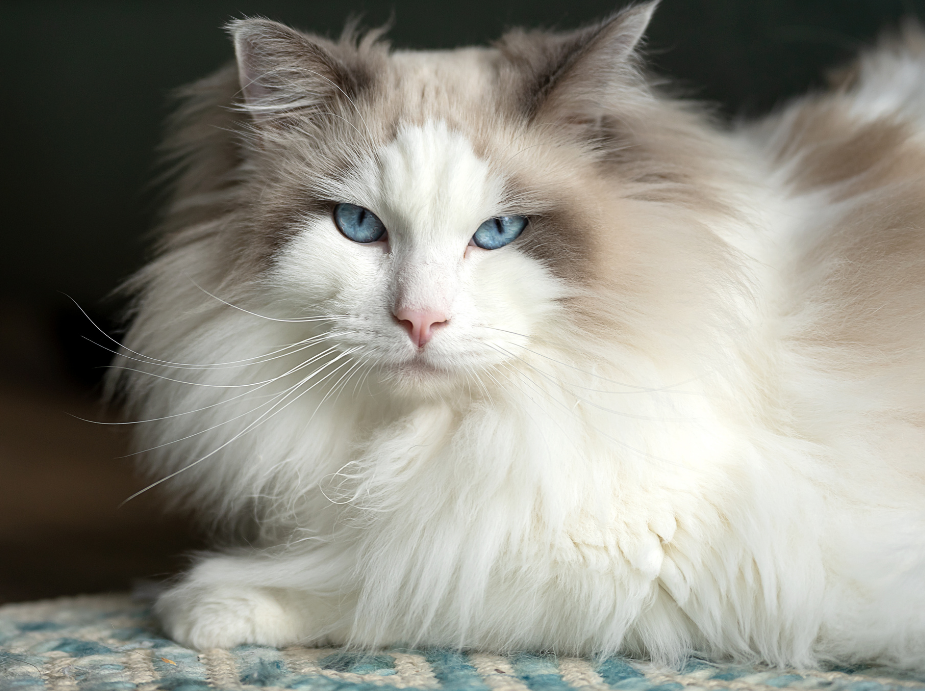
Ragdoll cats don’t climb high, and this unique trait sets them apart from many other feline breeds. Known for their docile nature, striking blue eyes, and plush coats, Ragdolls prefer to stay close to the ground, making them ideal companions for those seeking a laid-back pet. Understanding why Ragdoll cats avoid high perches and how to design a space that caters to their preferences can enhance their well-being and strengthen your bond. This article explores the reasons behind their grounded behavior and offers practical tips for creating a Ragdoll-friendly environment.
Understanding the Ragdoll Breed
Ragdoll cats, developed in the 1960s by breeder Ann Baker, are a large, affectionate breed known for their relaxed demeanor. Their name comes from their tendency to go limp when picked up, resembling a ragdoll. Unlike adventurous breeds like the Abyssinian or Bengal, Ragdolls are less inclined to scale furniture or leap to high surfaces. This behavior stems from a combination of their physical traits, personality, and genetic predispositions.
Physical Characteristics
Ragdolls are one of the largest domestic cat breeds, with males weighing 15-20 pounds and females slightly smaller. Their sturdy, muscular bodies are built for stability rather than agility. While they’re capable of jumping, their heavy bone structure makes climbing less appealing. Their long, bushy tails and semi-long coats add to their grounded appearance, as they prioritize comfort over acrobatics.
Temperament and Behavior
Ragdolls are often described as “dog-like” due to their loyal and social nature. They thrive on human interaction and prefer lounging near their owners rather than exploring high vantage points. This docile temperament reduces their desire to climb, as they feel secure and content at ground level. Their calm disposition also makes them less territorial, eliminating the need to claim high spaces to survey their domain.
Why Don’t Ragdoll Cats Climb High?
Several factors contribute to why Ragdoll cats don’t climb high. By understanding these, owners can better cater to their needs and create a safe, enriching environment.

1. Genetic Predisposition
Ragdolls were selectively bred for their gentle temperament and relaxed nature. Unlike breeds with strong hunting instincts, Ragdolls lack the drive to pursue high perches. Their breeding history prioritized companionship over athleticism, resulting in a cat that’s more interested in cuddling than climbing.
2. Physical Limitations
The Ragdoll’s large, heavy frame isn’t optimized for climbing. While they’re not clumsy, their size makes scaling furniture or cat trees less comfortable. Their joints and muscles are better suited for short bursts of activity, like playful pounces, rather than sustained climbing efforts.
3. Low Prey Drive
Many cats climb to mimic hunting behaviors, seeking high vantage points to spot prey. Ragdolls, however, have a subdued prey drive. They’re more likely to engage in gentle play, such as batting at toys, than to mimic predatory behaviors like stalking from above.
4. Comfort-Oriented Personality
Ragdolls prioritize comfort and security. High perches can feel exposed or unstable, especially for a breed that values cozy, safe spaces. They prefer soft beds, low platforms, or warm laps where they can relax without the risk of falling.
5. Trust in Their Environment
Ragdolls are highly trusting of their owners and surroundings. Unlike cats that climb to escape perceived threats or assert dominance, Ragdolls feel secure at ground level. Their confidence in their environment reduces the need to seek elevated hiding spots.
Designing a Ragdoll-Friendly Space
Creating a space tailored to a Ragdoll’s preferences enhances their happiness and health. Since Ragdoll cats don’t climb high, focus on low-level enrichment, comfort, and safety. Below are practical tips for designing their perfect environment.
1. Low-Level Cat Furniture
Traditional cat trees with high platforms may go unused by Ragdolls. Instead, invest in low, sturdy structures that cater to their grounded nature.
Low Cat Trees: Choose cat trees with wide, padded platforms no higher than 2-3 feet. These provide a slight elevation for lounging without requiring climbing.
Scratching Posts: Opt for horizontal or angled scratching posts. Ragdolls enjoy scratching but may avoid tall, vertical posts that require stretching upward.
Tunnels and Cubes: Ground-level tunnels and cozy cubes offer playful exploration and hiding spots, aligning with their love for secure spaces.
2. Cozy Resting Areas
Ragdolls adore soft, warm places to nap. Provide multiple resting spots to satisfy their comfort-driven nature.
Plush Beds: Place pet beds in quiet corners or near family activity areas, as Ragdolls love being close to their owners.
Heated Pads: Consider heated pet mats for colder climates, as Ragdolls are drawn to warmth.
Window Perches: Low window perches (close to the ground) allow Ragdolls to observe the outdoors without climbing.
3. Safe Play Zones
Ragdolls enjoy gentle play, so create safe, accessible play areas that encourage activity without vertical challenges.
Interactive Toys: Feather wands, laser pointers, and crinkle balls stimulate their playful side without requiring jumps.
Puzzle Feeders: These engage their minds and provide mental stimulation, perfect for a breed with a low prey drive.
Open Spaces: Ensure play areas are free of obstacles, as Ragdolls may be less adept at navigating cluttered environments.
4. Accessibility and Safety
Ragdolls’ larger size and relaxed nature make accessibility a priority. Design their space to minimize risks and maximize comfort.
Non-Slip Surfaces: Use rugs or mats on slippery floors to prevent accidental falls, as Ragdolls may not be as agile as other breeds.
Low Feeding Stations: Place food and water bowls at ground level to avoid strain. Elevated feeders can work if they’re only slightly raised for comfort.
Litter Box Placement: Choose large, low-entry litter boxes to accommodate their size. Place them in quiet, accessible areas to reduce stress.
5. Social and Bonding Areas
Ragdolls thrive on human interaction, so their space should encourage closeness with their owners.
Lap-Friendly Furniture: Provide comfortable chairs or sofas where you can cuddle with your Ragdoll, as they love physical closeness.
Shared Spaces: Designate areas where your Ragdoll can relax near you, such as a pet bed next to your desk or couch.
Calm Environment: Maintain a peaceful atmosphere, as Ragdolls are sensitive to loud noises or chaotic settings.
Health Considerations for Ragdoll Cats
While Ragdolls are generally healthy, their size and low activity levels require specific care to maintain their well-being. Designing their space with health in mind can prevent issues and promote longevity.

1. Weight Management
Ragdolls are prone to weight gain due to their relaxed lifestyle. Encourage gentle exercise through play and monitor their diet.
Portion Control: Feed high-quality, portion-controlled meals to prevent obesity.
Active Play: Use toys to encourage short bursts of activity, keeping them fit without overexertion.
2. Joint Health
Their large frames put extra stress on joints, especially as they age. A low-level environment reduces strain.
Soft Surfaces: Provide cushioned beds and mats to support their joints.
Regular Checkups: Schedule veterinary visits to monitor for arthritis or other joint issues.
3. Grooming Needs
Ragdolls’ semi-long coats require regular grooming to prevent matting, especially since they may not climb to self-groom in hard-to-reach spots.
Brushing Routine: Brush 2-3 times per week to keep their coat healthy.
Grooming Stations: Create a low, comfortable grooming area with a non-slip mat.
Common Myths About Ragdoll Cats and Climbing
Despite their grounded nature, myths about Ragdolls and climbing persist. Let’s debunk a few:
Myth: Ragdolls Can’t Jump: Ragdolls can jump but choose not to due to their size and temperament. They’re capable of short leaps but avoid high perches.
Myth: They’re Lazy: Ragdolls aren’t lazy; they’re simply less active than high-energy breeds. They enjoy play but prefer low-key activities.
Myth: They Don’t Need Enrichment: Ragdolls benefit from mental and physical stimulation, just in ways that suit their grounded lifestyle.
Conclusion

Ragdoll cats don’t climb high, and this endearing trait makes them unique among feline breeds. Their preference for staying grounded stems from their large size, gentle temperament, and comfort-driven nature. By designing a space that prioritizes low-level enrichment, cozy resting areas, and safe play zones, you can create an environment where your Ragdoll thrives. Understanding their behavior and needs allows you to build a home that celebrates their laid-back charm, ensuring a happy, healthy life for your feline companion.




